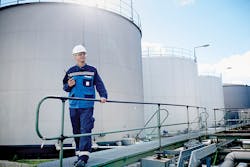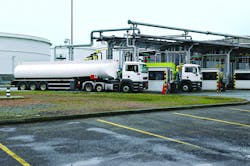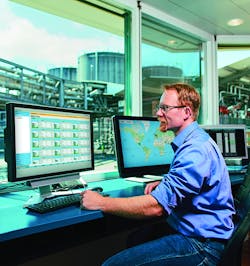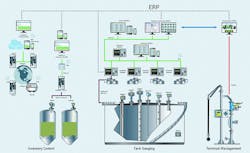Achieving zero loss at oil and gas terminals
Zero loss is a term used for the reconciliation of products in an oil and gas terminal. When the receipt of product coming in matches the billable amount of product going out, plus the inventory on hand, there is reconciliation with zero loss.
Stated another way, zero loss means dynamic level and flow measurements of incoming product match inventory on hand, plus dynamic level and flow measurements of the outgoing product. Level measurement accuracy with temperature correction is vital for true accountability to attain zero loss, as is accurate flow measurement.
Any deviation in reconciliation results in uncertainty regarding revenue. Is it reasonable to expect zero loss, and can operations perform to this level? The answer is yes. In fact, making improvements in key areas will result in a return on investment of a few months by significantly improving accounting and increasing revenue.
To achieve zero loss, three key areas need to be evaluated and improved. These include: tank inventory; loading and offloading of trucks, rail cars and ships; and integration of all systems with terminal management software.
Tracking tank inventory
A typical tank farm has many challenges that can lead to loss of profitability, including too much handling of product, no inventory transparency, high logistics and storage costs, trucks waiting for tank space to become available, operator safety, environmental safety, spills, leaks, theft, accounting for physical stock and unauthorized movements.
Many of these challenges can be overcome by simply upgrading tank level instrumentation. Upgrading and adding level instrumentation can reduce required manual work up to 50% while increasing personnel safety — for example, by keeping workers off the top of tanks — and it can be used to detect leaks and spills.
Recent developments in automatic tank gauging make it possible to measure tank inventory at the tank itself. In other words, instrumentation can measure tank level, compensate for temperature and calculate the exact volume — even on odd-shaped tanks or tanks that deform when filled. It is no longer necessary to rely on software in a remote system to calculate volume on hundreds of tanks based on sometimes inaccurate level measurements.
Annual cost savings can be obtained when steps are taken to improve accuracy of tank level and volume measurements. For example, a 100-foot-diameter tank with a typical level measurement error of 2 millimeters has a constant error of as much as 15.6 barrels. Without temperature correction, even a 1-degree temperature shift can result in an error of 0.1% of volume, or 78.6 barrels. If that tank is loaded from ships or pipelines and unloaded into trucks or rail cars 100 times a week, the errors accumulate, resulting in an unaccounted loss of $350,000 (for crude oil at a price of $50/barrel) every year.
With automatic tank gauging, volume measurements are much more accurate, approaching zero loss. And when combined with tank terminal software tracking inventory in all tanks, such a system can be used to detect theft and unauthorized movements. Similar problems occur with truck and rail loading and offloading.
Loading and offloading
In general, the manual processes required when using traditional weigh scales or manually reading level gauges to determine how much product is being loaded or offloaded can be inaccurate. This results in high uncertainty and excessive labor costs compared to the use of automated loading skids.
Adding modern level and flow instrumentation to a truck/rail loading and offloading system (see Figure 2) greatly improves accuracy and helps terminals achieve zero loss.
Figure 2. Modern level and flow instrumentation is more accurate than traditional weigh scale operations when loading trailers or tank cars.
One terminal installed a skid loading/offloading system to replace its weigh scales. The system used Coriolis flowmeters to measure flow, volume and density of product being transferred. The accurate flowmeters ensured the rail cars and trucks received and delivered the right amount of product.
The customer estimates that its combined savings from zero loss accounting, reduced labor and improved safety was nearly $350,000 annually. Because workers no longer had to operate or maintain weigh scales, required manual work was reduced by approximately 66%, and downtime due to weigh scale maintenance was eliminated.
In this example, more efficient use of loading bays allows for faster truck loading. By integrating order management and loading software with the instrumentation, efficiency increased by at least 25%. Typically, the time to load a truck dropped from one hour to 45 minutes. Safety was improved because of the instrumentation’s overfill prevention system and because operators were not allowed to touch the product during delivery or offloading.
Data from both the tank inventory and loading/offloading systems is now sent in real time to the tank farm’s terminal management software system, so they always know exactly how much product is in the tanks, what product is coming in and what product is going out.
Integration with inventory management software
In terminals not equipped with automatic tank gauging and terminal management software, operators often complain about the significant effort needed to evaluate and correct inventory and load data. Data may finally be entered days or weeks after it was manually measured and written down, and it may have been entered in multiple different areas, with possible human error at each step.
Other problems include the need to plan for higher safety stock levels to avoid run-outs, production stops or lost sales. Emergency deliveries are occasionally needed when product run-outs occur, and products can become obsolete or depreciate from being in storage too long.
A terminal can solve these problems by integrating tank volume and loading/offloading measurements into a terminal management software system, allowing the right information to be delivered at the right time and place to relevant personnel.
To meet the various communication needs of tank farms and terminal management software systems worldwide, level, flow and automatic tank gauging instruments are available with Modbus, 4-20 mA HART, fieldbus and other standard two-way digital communication links. This enables integration of instrumentation into any terminal management software system.
Capabilities of terminal management software typically include:
- Safety management: Provides overfill prevention according to API 2350 or SIL requirements along with leakage detection.
- Inventory management: Tracks how much raw material or finished products are on-site, how much storage space is available, and product gain and loss balance during processing, transportation and storage.
- Human-machine interface (HMI) screens: Provide a graphical summary of the tank farm inventory based on actual tank shapes, temperature correction per API, trending and reporting (see Figure 3). They also provide information on tank inventories based on tank group, buyer, location, product and status. And, HMI software provides complete loading and offloading control and monitoring for the operation of a terminal, including inventory management and access to enter the terminal.
Figure 3. Endress+Hauser’s Tankvision software provides inventory data on HMI screens.
Benefits can include reduced manual work from data gathering and reconciliation efforts; reduced holding inventory by up to 10% per product due to improved accuracy and confidence; and reduced storage and risk costs.
Terminal management software (see Figure 4) running on a separate PC/HMI system can operate independently of the tank farm’s control system or it can share data with the control system.
Figure 4. Endress+Hauser’s Tankvision, terminal vision and Supplycare software packages work with automatic tank gauging instrumentation to provide zero loss in a tank farm.
Conclusion
Achieving zero loss requires modern level instrumentation, automatic tank gauging to calculate the volume of products in tanks, accurate rail/truck loading and offloading systems and terminal management software. This type of system helps remove uncertainty, significantly reduces unaccounted losses and improves safety. It is also cost efficient over time.
Dean Mallon was the national product manager of level/tank gauging at Endress+Hauser at the time this article was written. He has more than 34 years of experience in chemical, petrochemical, refining and terminal automation, holding positions as a company owner and instrumentation sales. Mallon has worked with the American Petroleum Institute for more than 10 years — involved with the API 2350 overfill protection working group and most recently the 5th edition currently being reviewed for publication.






